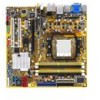Asus M2N-VM DH Motherboard Installation Guide - Page 17
wireless station is, the better signal and transmit speed it receives. To improve your
 |
View all Asus M2N-VM DH manuals
Add to My Manuals
Save this manual to your list of manuals |
Page 17 highlights
2.1.3 Signal range The signal range of WiFi-AP Solo depends on the operating environment. Obstacles such as walls and metal barriers could reflect or absorb radio signals. Devices such as microwave stove can also greatly interfere with the wireless network. Signal range: 802.11g: Indoor 80ft (30m), outdoor (LOS, Light-Of-Sight) 200ft (60m) 802.11b: Indoor 130ft (40m), outdoor (LOS, Light-Of-Sight) 1000ft (310m) By default, the device automatically adjusts the data rate and the closer the wireless station is, the better signal and transmit speed it receives. To improve your wireless transmission, move your wireless stations closer to the WiFi-AP Solo. 2-3

2-3
2.1.3
Signal range
The signal range of WiFi-AP Solo depends on the operating environment.
Obstacles such as walls and metal barriers could reflect or absorb radio signals.
Devices such as microwave stove can also greatly interfere with the wireless
network.
Signal range:
802.11g: Indoor 80ft (30m), outdoor (LOS, Light-Of-Sight) 200ft (60m)
802.11b: Indoor 130ft (40m), outdoor (LOS, Light-Of-Sight) 1000ft (310m)
By default, the device automatically adjusts the data rate and the closer the
wireless station is, the better signal and transmit speed it receives. To improve your
wireless transmission, move your wireless stations closer to the WiFi-AP Solo.














